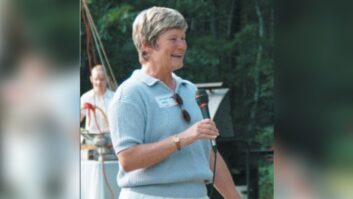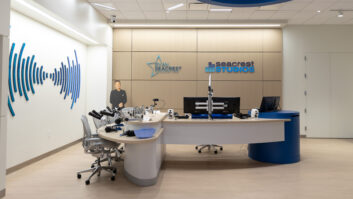On Election Day in Middlesex County, Mass., voters in several towns were asked whether the old Fort Devens Army base should incorporate as the state’s first new town in 86 years.
Among those standing outside the polling place and holding signs in favor of the initiative was a 63-year-old grandmother who recently retired to Maine but had come back to speak up for taxpayers she feels are disenfranchised.
If you’d gone to the polls that day, you might have done a double-take and realized the woman holding the sign was Lynn Cheney, former president and majority stockholder of Comrex Corp., lending her voice to the community debate.
Cheney has retired from the company she joined in 1974 and helped shape for many years. To me, she represents the best that our broadcast equipment industry has to offer. She is a forthright, capable leader who competed for business vigorously, was always affable with her competitors and has genuine affection for her employees and clients. She contributed to, and then presided over, the growth of a successful — and proudly efficient — equipment manufacturer, through decades that have seen great change in radio and in the company’s business model.
Her departure leaves Comrex without a Cheney for the first time since its founding 45 years ago.
Appeals meeting
It had not been her intention to enter a career in broadcast electronics. Lynn Everett studied French at Wellesley when professional opportunities for women were limited. “At the time I went to college, you got married.” Her career opportunities included teaching, translation and writing. She wed George Distler and took a job for the Sudbury newspaper, where she was paid by the column inch.
One day, while covering the business of government, she met local appeals board member John Cheney. He had started a company in 1961 making wireless microphones. Business had slowed by the early 1970s, and he’d been doing mostly consulting work for manufacturing companies including Telex and Magnecord. But the transistor age also had arrived and was giving Comrex a new life. John designed a crystal-controlled UHF wireless system that came out just about the time ENG cameras for television hit the market in a big way. This 450 MHz product was a success.
He needed someone to help answer the phones, so he offered journalist Lynn Distler a position working three hours a day, three days a week. He didn’t know he was hiring his future wife and business partner.
It was also Lynn’s baptism into business. “I remember going home, getting George a martini and asking him, ‘What’s an account receivable?’ I was a French major!”
It didn’t take her long to get savvy. She attended the next NAB show, held at the time in Chicago, and hasn’t missed one in 31 years. (Exhibitors in that period were unhappy with the way the convention was run, and there was talk of a manufacturers’ association. NAB formed an exhibitors’ advisory committee to help with communication; Lynn Distler was named to the group. Three decades later Comrex remains an active voice in exhibitor matters.)
Business extension
Over the years, Lynn came to realize she was receiving a second education. “John was the best teacher I’ve ever run into. It was the first time I ever productively took the square root of anything. I learned a lot of physics, engineering, the broadcast business. It’s very intuitive, it’s a logical skill set as to how things work.
“As an example of John’s role as a teacher, I remember Tom Hartnett came to us right out of college. He was working at a local station; we weren’t particularly looking to hire at the time, but he said he wanted to be a design engineer. He admired our products and he wanted to learn from John. I think we had five employees. I told John, ‘If you don’t want him as an engineer, I’ll take him as a salesman.’ Tom’s now one of the finest design engineers in the business and he attributes much of his success to being John’s protégé.”
Comrex soon made its splash in radio with frequency extension, a technology that allowed delivery of better audio quality over regular phone lines. “That came out of single-sideband technology and phase-shifting the audio up. John also had had strong experience in telephony, working for the Army and afterwards. That put us into the whole telephone business, and that’s what we’re still doing: sending high-quality audio on readily available communications circuits, even today with IP products.”
This direction took the company through multi-line frequency extension products, to ISDN codecs, then to POTS codecs in the late 1990s with its Hotline product. “Technology has changed dramatically. It used to be every 10 years I’d see Comrex reinvent itself; now it’s more like every five years.”
She expects that trend to continue. “Every time we turn around the communications world has changed.” Switched networks will continue to migrate. “ISDN will be the first thing to go; then practically all of telephony will be on an IP-based platform. That’s where we’ve been putting our money and time, resulting in the Access.”
She says proudly that the company has always been managed collaboratively. “John was not a dictator. I remember one time when I was trying to put our inventory on computer. I think the Apple IIe was state-of-the-art; and I got a microprocessor-based manufacturing package online, a Unix system. I came back from a trip to Cleveland to learn about it and I said, ‘Do you realize you use 25 kinds of 10-microfarad capacitors? Settle on one!’ Nobody here wears one hat.” Similarly, it was Peter Burk, then a Comrex employee, who urged the firm to move from direct sales to a dealer distribution structure.
Cheney says the character of the radio equipment sales community has changed over her time.
“I love my colleagues, by and large. We’re a group of honorable, interesting companies. That being said, there’s been an awful lot of amalgamation; and sometimes some of the players get lost in the process. I miss Roy Ridge’s Allied Equipment. It’s just not the same company; and there are other companies in that situation. I don’t know how productive it is for a small manufacturer to be subsumed by a larger firm.”
She looks back fondly on the friends she’s made in equipment sales who have served as sounding boards. She mentions Jack Williams of PR&E and his family, and Tim Schwieger of BSW.
“It’s a good business. It’s also become much more internationalized — though I think unlike other industries, the U.S. manufacturers still have the edge. This is where radio was born, and the international world knows that and sees that.”
Employee-owned
George Distler, still a young man, died in 1981. Lynn would eventually marry John Cheney and continue to grow in her role as manager, learning from John and what she describes as his “passion” for creating a well-run manufacturing organization.
When John died in 1998, Lynn, twice widowed but vigorous in her mid-50s, became president. She moved quickly to round up shares held outside the business and launched an employee stock ownership plan.
“I don’t believe that privately held companies of our size should have outside shareholders; I believe in the value of having the people who work in the company own the company.” Comrex is now employee-owned and is managed by majority shareholders Kris Bobo and Tom Hartnett, who have been much involved in decision-making. Cheney remains on the board and consults.
“I’m available as long as I’m of use, but at this point Kris and Tom are fully capable of running the company, and are.”
She’s going to have a hard time cutting herself loose completely, though. “I’ve been in it so long now, it’s been in my blood. I love the business and the people in it.” She expects to attend NAB in the spring; she recently visited community station WERU(FM) in Blue Hill, Maine, and offered her technical expertise.
“It’s been satisfying to keep on learning. It’s my one fear in retirement. Comrex has always been challenging to me personally, and I’d like to keep that kind of challenge in my life.” Not that she’s found herself wondering what to do. She enjoys the outdoors and lives 40 minutes from Maine’s Acadia National Park. At her going-away party, Comrex employees presented her with a model of a full-size kayak that is being custom-built for her. She gardens and spends time with her daughters and grandchildren.
She also still has an interest in the Fort Devens debate. Comrex moved four years ago to a building it had purchased on the grounds of the old Army facility. Cheney has served on a committee to decide the future of the property, which has become a business magnet but is split among three jurisdictions. Its future remains uncertain.
I asked Lynn to straighten me out on how to write her name. At Comrex she was Lynn Distler at first, and that is how many folks still know her. But to help keep her government paperwork straight, she recently settled officially on Lynn Cheney. “Here in liberal Massachusetts I introduce myself as ‘Lynn-Cheney-not-wife-of-Dick.’ Even Wellesley gets me confused; they once wrote me a letter congratulating me on an article I’d written called ‘The Decline of the Dutiful Wife.’
“No, that wasn’t me!”











